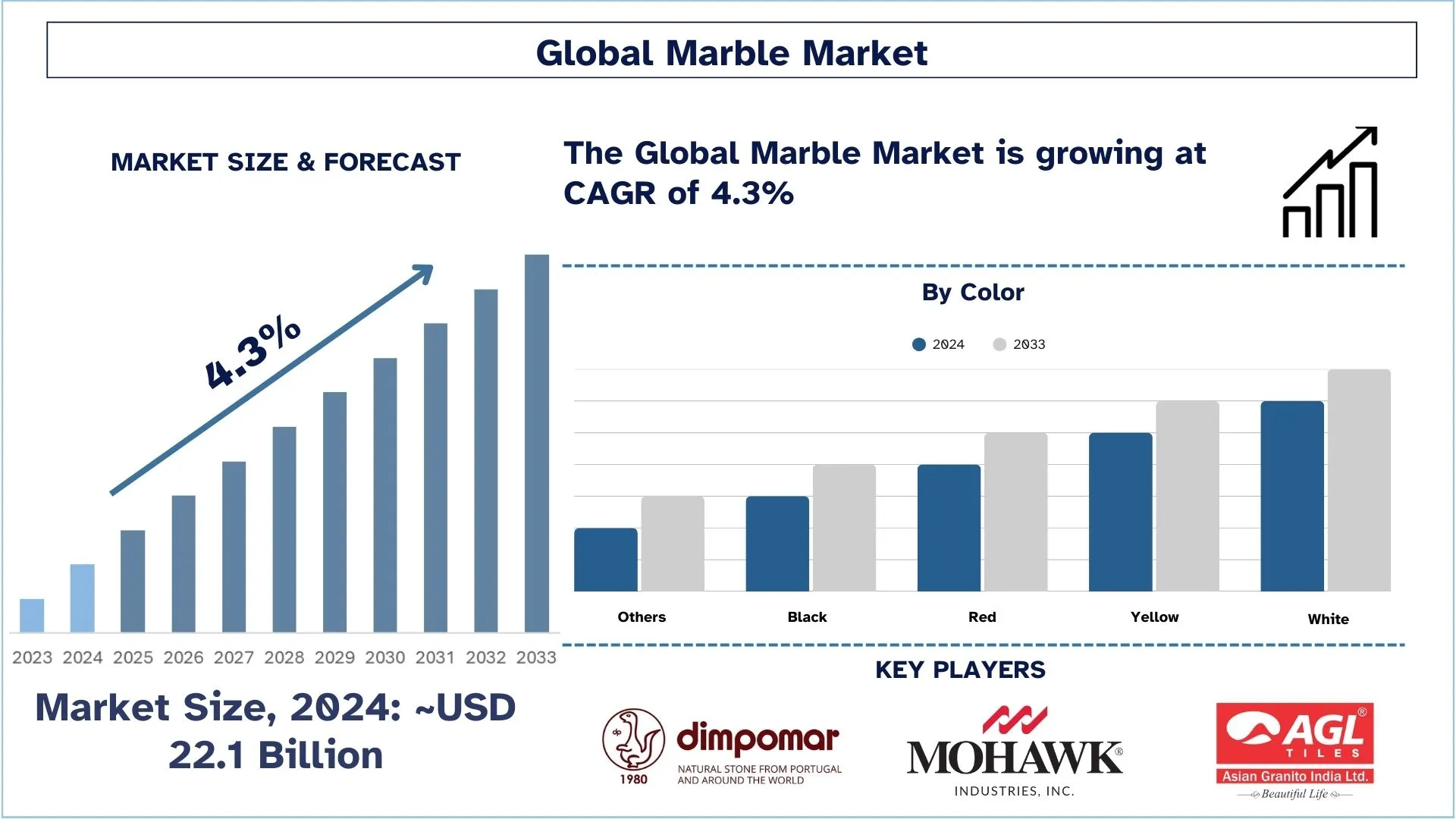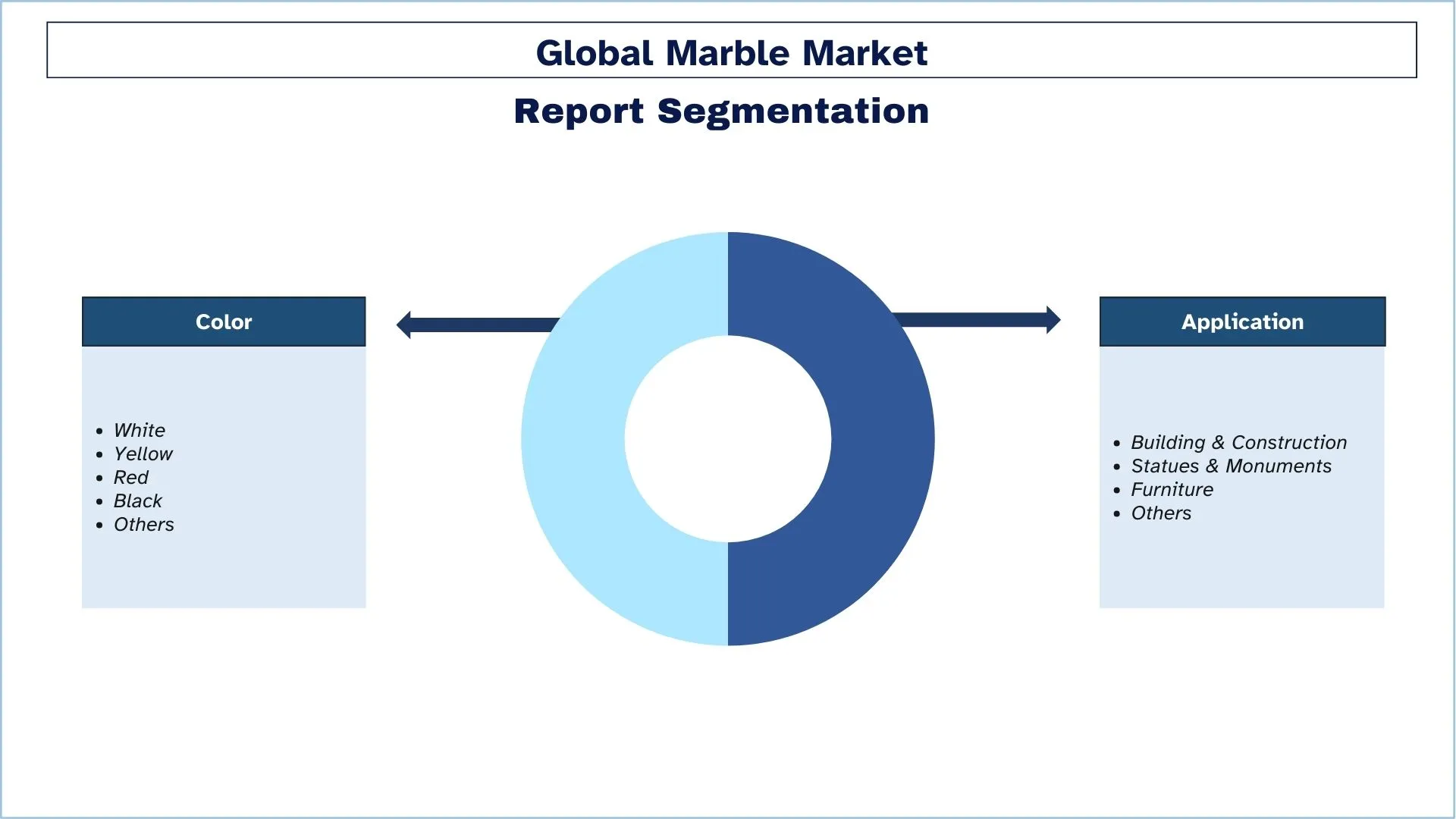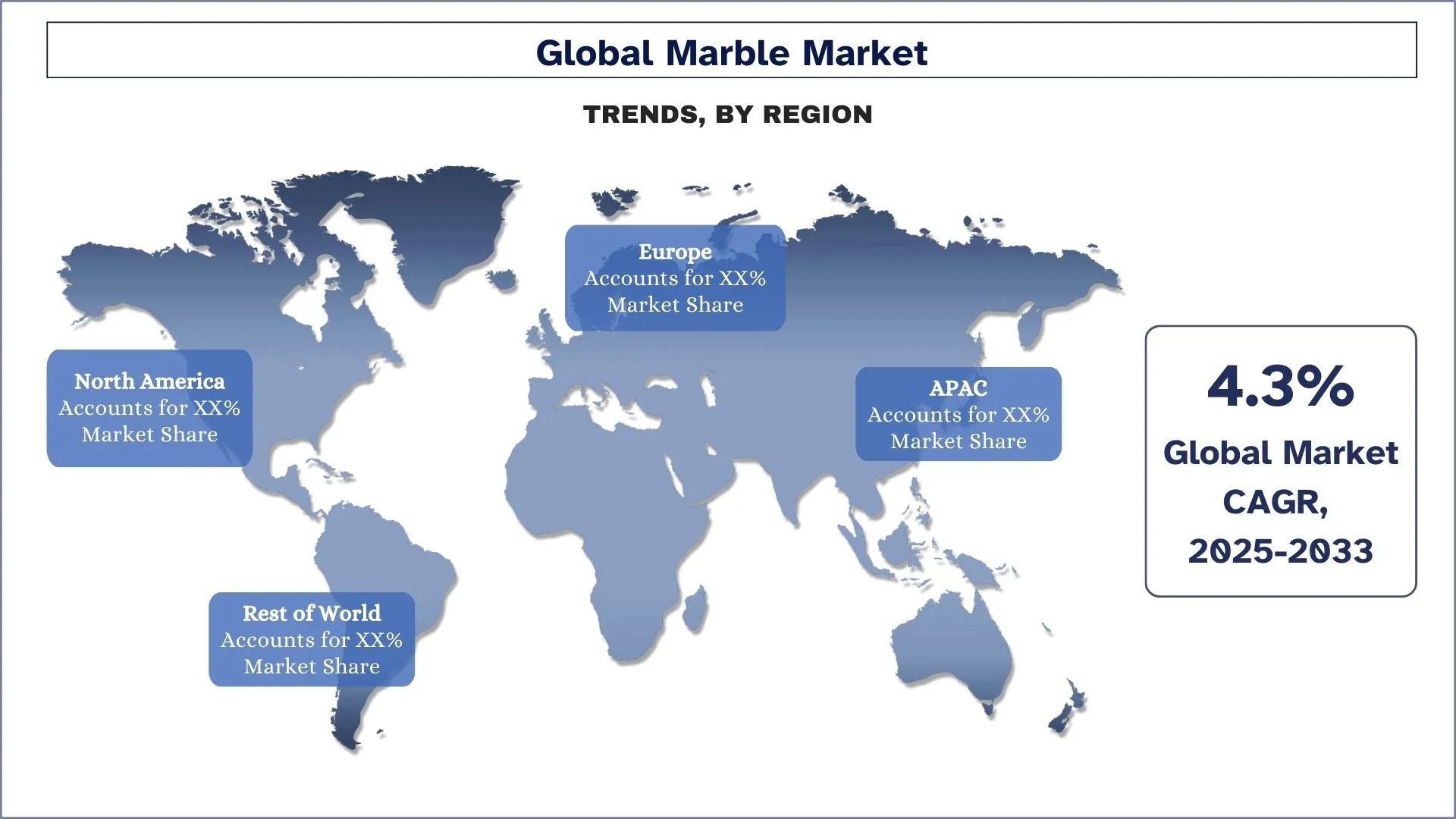
大理石市場規模與預測
2024年大理石市場的估值約為 221 億美元,由於對豪華和高端建築的需求不斷增長,預計在預測期(2025-2033 年)內將以約 4.3% 的可觀複合年增長率增長。
大理石市場分析
大理石是一種變質岩,在受到高溫和高壓時會形成石灰石。它具有半透明的特性,允許光線進入並發出柔和的光芒。大理石也可以進行非常高的拋光。因此,它也被用於製作雕塑和建造紀念碑。此外,與其他天然石材相比,大理石具有更高的耐用性。諸如大理石越來越多地用於製作雕塑和建造紀念碑等因素。在全球大理石市場上運營的公司正在進行合作協議,例如合併和收購、產品發布以及類似的策略,以在市場競爭中獲得領先地位。例如,2022 年 2 月,Cupa Group 通過 Burton Roofing 宣布收購 100% Discount Roofing,這是一家專門從事屋頂產品分銷的公司。通過這筆交易,該公司加強了其在英國市場的業務,並保持了其在石板行業的領導地位。
大理石市場趨勢
本節討論了我們的研究專家確定的影響大理石市場各個細分市場的關鍵市場趨勢。
通過創新和效率徹底改變大理石行業
數位轉型是大理石行業的主要新興概念。大理石公司使用現代技術來實施數位工具,例如 3D 列印和 AI,以及虛擬設計軟體來進行運營。創新改變了設計和客製化程序,以便承包商可以實現複雜而準確的大理石應用,用於建造建築物和設計室內裝飾。部署數位工具的企業可以提高其生產效率,同時減少浪費產生並提高其運營績效,並為其客戶提供一系列客製化和創新的產品。
大理石行業細分
本節分析了全球大理石報告每個細分市場的關鍵趨勢,以及 2025-2033 年全球、區域和國家層面的預測。
白色大理石市場佔據最大的市場份額。
根據顏色,大理石市場分為白色、黃色、紅色、黑色和其他顏色。預計白色大理石在預測期內將以強勁的複合年增長率增長。白色大理石是最流行和廣泛使用的大理石顏色,它通常與奢華、優雅和精緻相關聯。白色大理石被廣泛應用,包括建築、建築和室內設計。在建築方面,它通常因其強度和耐用性而被用於生產建築材料,例如檯面、地板和牆磚。它也用於生產雕塑和其他裝飾元素。因此,這些因素正在增加對白色大理石的需求,進而推動了全球大理石市場的發展。
建築與施工領域預計將比大理石市場呈現更高的複合年增長率。
根據應用,大理石市場分為建築與施工、雕像與紀念碑、家具和其他。在所有這些領域中,建築與施工在 2024 年佔據了顯著的市場份額。由於其強度、耐用性和美觀性,大理石是建築商和建築師的熱門選擇。在建築行業中,大理石被廣泛應用,包括生產建築材料,例如檯面、地板和牆磚。它也用於生產雕塑和其他裝飾元素。大理石通常用於高端住宅和商業建築的建造,以及歷史建築的修復。它也用於生產公共建築,例如博物館、圖書館和政府建築。因此,這些因素正在增加建築與施工市場,進而推動大理石市場的發展。

2024 年亞太地區佔據了重要的市場份額。
預計亞太地區在預測期內將顯著增長。這主要是由於該地區擁有龐大且不斷增長的中產階級,他們越來越富裕並且擁有更高的可支配收入。這導致了對奢侈品(包括大理石)的需求增加,大理石通常與高端和獨家產品相關聯。此外,該地區擁有龐大且不斷增長的建築行業,這是大理石的主要消費國。大理石被用於生產各種建築材料,包括檯面、地板和牆磚,以及生產雕塑和其他裝飾元素。此外,許多大型且不斷增長的旅遊業也是大理石的主要消費國。大理石通常用於酒店、度假村和其他旅遊景點的建造,以及生產紀念品和其他禮品。因此,這些因素正在增加該地區對大理石的需求。
中國主導亞太地區大理石市場
由於城市發展的快速步伐和不斷增長的基礎設施需求,以及住宅和商業建築中不斷增長的建築材料需求,中國大理石產品市場保持強勁增長。這個發展中國家每年都需要更多的大理石,因為它提供了持久的美感,以及各種用途的靈活性和強大的性能。中國大理石行業繼續發展環保措施,例如綠色採礦技術和環保生產工藝。儘管最近的行業進展,但該市場面臨兩大挑戰,其中包括環境法規和來自瓷器和花崗岩材料的激烈競爭。由於新技術的發展和即將到來的增長前景,大理石業務在未來顯示出強大的潛力。

大理石行業競爭格局
大理石市場競爭激烈,有多家全球和國際參與者。主要參與者正在採取不同的增長策略來增強其市場地位,例如合作夥伴關係、協議、協作、新產品發布、地域擴張以及合併和收購。
頂級大理石公司
在市場上運營的一些主要參與者包括 Asian Granito India Limited、Dal-tile Corporation (Mohawk Industries)、Dimpomar – Rochas Portuguesas Lda、Levantina Y Asociados De Minerales S.A.U.、Temmer Marble、Topalidis S.A.、Hellenic Granite Company S.A.、Namco Co. Srl、Fox Marble Holdings Plc、Delta Marble、Mining, Construction Import and Export Inc.
大理石市場的最新發展
2023 年, Polycor Inc. 完成了對 ROCAMAT 的收購,ROCAMAT 是國際建築石材生產行業的重要參與者,也是法國領先的天然石材生產商。ROCOMAT 擁有四家轉型工廠,並在法國經營著 30 個石灰石採石場。此次收購將為 Polycor 集團在法國創造新的增長機會。
2022 年, Antolini Luigi & Cspa 推出了 Azerocare Plus,這是一種創新的工藝,專門針對 LETHER 和 MATT 飾面的瑪瑙、大理石和軟石英岩表面,以及僅在 MATT 飾面中的石灰華,它可以防止由於接觸酸性物質(例如葡萄酒和檸檬)而引起的污漬和腐蝕。
大理石市場報告覆蓋範圍
報告屬性 | 詳細資訊 |
基準年 | 2024 |
預測期 | 2025-2033 |
增長動能 | 以 4.3% 的複合年增長率加速增長 |
2024 年市場規模 | 221 億美元 |
區域分析 | 亞太地區、歐洲、亞太地區、世界其他地區 |
主要貢獻區域 | 預計亞太地區在預測期內將以最高的複合年增長率增長。 |
涵蓋的主要國家 | 美國、加拿大、德國、法國、英國、西班牙、意大利、中國、日本和印度 |
公司簡介 | Asian Granito India Limited、Dal-tile Corporation (Mohawk Industries)、Dimpomar – Rochas Portuguesas Lda、Levantina Y Asociados De Minerales S.A.U.、Temmer Marble、Topalidis S.A.、Hellenic Granite Company S.A.、Namco Co. Srl、Fox Marble Holdings Plc、Delta Marble、Mining, Construction Import and Export Inc. |
報告範圍 | 市場趨勢、驅動因素和限制因素;收入估算和預測;細分分析;需求和供應方分析;競爭格局;公司簡介 |
涵蓋的細分市場 | 按顏色、按應用、按地區/國家 |
購買大理石市場報告的原因:
該研究包括經過驗證的關鍵行業專家驗證的市場規模和預測分析。
該報告提供對整體行業績效的快速回顧。
該報告涵蓋了對傑出行業同行深入分析,主要側重於關鍵業務財務、產品組合、擴張策略和最新發展。
詳細檢查行業中存在的驅動因素、限制因素、關鍵趨勢和機遇。
該研究全面涵蓋了跨不同細分市場的市場。
對行業進行深入的區域層面分析。
客製化選項:
全球大理石市場可以根據要求或任何其他細分市場進一步客製化。此外,UnivDatos 了解到您可能擁有自己的業務需求;因此,請隨時與我們聯繫以獲取完全符合您要求的報告。
目錄
大理石市場分析研究方法 (2023-2033)
我們分析了歷史市場,估算了當前市場,並預測了全球大理石市場的未來市場,以評估其在全球主要地區的應用。我們進行了詳盡的二級研究,以收集歷史市場數據並估算當前的市場規模。為了驗證這些見解,我們仔細審查了大量的研究結果和假設。此外,我們還與大理石價值鏈上的行業專家進行了深入的初步訪談。通過這些訪談驗證市場數據後,我們使用由上而下和由下而上的方法來預測整體市場規模。然後,我們採用市場細分和數據三角測量方法來估算和分析行業細分市場和子細分市場的市場規模。
市場工程
我們採用數據三角測量技術來最終確定整體市場估算,並得出全球大理石市場每個細分市場和子細分市場的精確統計數據。通過分析各種參數和趨勢,包括顏色、應用和全球大理石市場內的區域,我們將數據分成幾個細分市場和子細分市場。
全球大理石市場研究的主要目標是
該研究確定了全球大理石市場的當前和未來趨勢,為投資者提供了戰略見解。它突出了區域市場的吸引力,使行業參與者能夠進入未開發的市場並獲得先發優勢。研究的其他定量目標包括:
市場規模分析:評估全球大理石市場及其各個細分市場的當前和預測市場規模,以價值(美元)計。
MARBLE 市場細分:該研究按顏色、應用和區域對市場進行細分。
監管框架 & 價值鏈分析:檢查大理石行業的監管框架、價值鏈、客戶行為和競爭格局。
區域分析:對亞太地區、歐洲、北美和世界其他地區等主要區域進行詳細的區域分析。
公司簡介 & 增長策略:大理石市場的公司簡介以及市場領導者為維持快速增長的市場而採用的增長策略。
常見問題 常見問題
Q1:目前大理石市場的規模和增長潛力是什麼?
2024年全球大理石市場估值約為221億美元,預計到2033年將以4.3%的穩健複合年增長率增長。
Q2:推動大理石市場增長的驅動因素有哪些?
大理石市場增長的主要驅動力是對豪華建築和高端室內設計的強勁需求。隨著全球城市化進程加速,大理石等優質建材因其美觀性、耐用性和價值而越來越廣泛地被使用。
Q3:依顏色區分,哪個市場佔大理石市場的最大份額?
在全球大理石市場中,白色大理石在顏色板塊中佔據主導地位。
第四季:大理石市場的主要趨勢是什麼?
大理石市場的一個主要趨勢是越來越重視永續性。各公司正在採用環保的採礦方法、回收材料,並利用綠色技術來減少對環境的影響。這種趨勢與綠色建築專案中對永續建築材料日益增長的需求相一致。
Q5:哪個地區將主導大理石市場?
由於中國和印度等快速城市化國家的強勁需求,以及對基礎設施、商業空間和豪華住宅建築的大量投資,目前亞太地區引領著全球大理石市場。
Q6:大理石市場中最大的挑戰是什麼?
大理石市場的主要挑戰包括嚴格的環保法規、環保採礦流程的高成本,以及花崗岩和瓷器等替代材料的可用性。 這些因素可能會增加營運複雜性並影響利潤率。
Q7:全球大理石市場的主要參與者有哪些?
在 MARBLE 領域引領創新的領先公司包括:
• Asian Granito India Limited
• Dal-tile corporation (Mohawk Industries)
• Dimpomar – Rochas Portuguesas Lda
• Levantina Y Asociados De Minerales S.A.U.
• Temmer Marble
• Topalidis S.A.
• Hellenic Granite Company S.A.
• Namco Co. Srl
• Fox Marble Holdings Plc.
• Delta Marble
Q8:哪些關鍵技術進步正在塑造大理石產業的未來?
大理石產業正在經歷數位轉型,採用了 3D 列印、AI 驅動的設計軟體和自動化切割技術。這些創新技術可以實現更精確的大理石切割、減少浪費,並支持建築領域中客製化的大理石應用。此外,永續採礦技術的進步正在幫助企業達到環境標準,同時提高效率。
Q9:哪些地區對大理石的需求最高?哪些是市場擴張的新興機會?
由於對豪華房地產和高端商業空間的投資不斷增加,亞太地區和北美地區的大理石需求量最高。隨著城市發展的加速,中東和非洲的新興市場也提供了增長機會。綠色建築和可持續建築的日益普及進一步推動了對環保大理石產品的需求。
相關 報告
購買此商品的客戶也購買了










